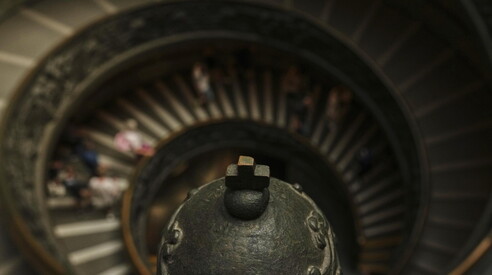In an age of authoritarianism and democracy, rediscovering Jacques Maritain. The exhibition at the Vatican Museums.


LaPresse
the exhibition
The exhibition draws from the treasures of the Collection of Modern and Contemporary Art, which owes its existence to Paul VI and Maritain, to the debate on sacred art triggered in France and to the artists involved in it, including Matisse.
On the same topic:
Whether Western civilization already has a nail in its coffin or lies "only" in intensive care with a slim hope of recovery (it's happened before in history, so let's be cautious...), things don't change: it doesn't have the long-term "Non praevalebunt" insurance policy issued to the Church of Our Lord and His lieutenant Peter. For the West, the equally New Testament caveat applies: et si domus contra se dividatur, non poterit domus illa stare (a house divided against itself cannot stand). Certainly, in its millennia-long history, Western civilization has incurred formidable internal fractures—just think of the Italo-German totalitarian swerve of the twentieth century, despite many conflicting interpretations, from Nolte to Adorno—and it has survived for better or worse. Today, however, with the Atlantic expanded beyond measure; America – the main contributor and guarantor of Westernism for the last two centuries – in the grip of a mad narcissism; and the Old Continent – the historic hotbed of Western values – weakened by depressive apathy, we are once again navigating very perilous waters . So, we are prepared, yes, but how can we prepare for the possible collapse of our home? I admit that such a prospect may seem gloomy, but only through this lens, and animated by the afterthought of what to pack for the possible exodus towards – or awaiting the advent of – other civilizations (Muslim? Chinese? Techno-transhumanist? Post-apocalyptic?), can I observe two small cultural facts: both concern Jacques Maritain , the bold and indomitable cultural warrior of the twentieth century whom the victorious general Charles de Gaulle sent to Rome just eighty years ago as French ambassador to the Holy See.
This seemingly irrelevant anniversary, however, is being addressed in a refined and eloquent exhibition at the Vatican Museums, curated with customary verve and insight by Micol Forti. Indeed, in a time of Nietzschean, Schmittian, and Girardian cultural apogee, the figure of the integral humanist—that is, Christian— Maritain seems distinctly out of place, out of place, and out of focus; his contribution to the construction of a globally recognized cultural-legal-philosophical order of the world, his attempt to establish universal human rights (ultimately the UN), his repêchage of Thomism —he, a Protestant, then an atheist, converted to Catholicism with his brilliant wife, Raïssa, a Russian Jew from Mariupol—sound like noble but bland pathos, lacking the nerve needed for these iron-clad times. The Vatican took a different view, placing Maritain at the crossroads of the postwar renewal of sacred art, associating him with the gentle Paul VI; a theme somewhat peripheral to today's global crisis, it may be said, but one with multiple implications. What stands out most, even before the individual content, is the method by which seemingly moribund civilizations revive, renew, and reassert themselves. And this method is a delicate and precious shell: the personal friendship within which each individual's intimate faith (religious, artistic) spreads in an indomitable collective fire. Just reread the captivating and moving Les Grands Amis by Raissa Maritain (someone, republish it!), which tells the story of a small but colossal group of personalities (Bloy, Péguy, Rouault, Chagall, Bergson, and others) who overturned the cultural destiny of early 20th-century France, seemingly doomed to a sarcophagus-like, socialist-leaning anticlericalism. But it's also enough to follow the thread of the friendship between Montini and Maritain to understand the power that certain small atoms of humanity can unleash.
The exhibition, which deserves a different location (those who enter the Vatican Museums generally aim for different targets: the Sistine Chapel, Raphael's Rooms, the Pinacoteca, etc.), draws from the treasures of the Collection of Modern and Contemporary Art, which owes its existence to Paul VI and Maritain, to the debate on sacred art sparked in France and to the artists involved, including Matisse. It is curious how at the same time that the pompous cultural establishment beyond the Alps was decreeing the extinction of Christianity, in secluded Catholic gardens, sprouts were being cultivated that would produce a sensational inflamed effect on the entire Catholic galaxy (one would hardly think that pontiffs like Wojtyła and Ratzinger arise from nowhere! For example, read the story of Montini's fundamental text, The Credo of the People of God, ghostwritten by Maritain). Thus, beyond the Tiber, paintings, portraits, photographs, sketches, and documents evoke an extraordinary human and intellectual adventure; Meanwhile, from the secular but enlightened Olivetti circles comes the timely single-volume republication of Maritain's essays The Rights of Man and Natural Law (1942) and Christianity and Democracy (1943), published by Edizioni di Comunità. Precious pages in an age of illiberal authoritarianism and aggressive democracies, of amoral legal positivism and oppressive unilateralism. Yes, in my memoranda for tackling an unknown future civilization, the "old-fashioned" Maritain cannot be missing.
More on these topics:
ilmanifesto




